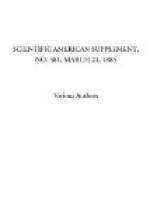* * * * *
DOBSON AND BARLOW’S IMPROVEMENTS IN HEILMANN’S COMBERS.
Next to the mule, there is no doubt that the most beautiful machine used in the cotton trade is Heilmann’s comber. Although the details of this machine are hard to master, when once its action is understood it will be found to be really simple. The object of combing is to remove the short staples and the dirt left in after the carding of the cotton, such as is used in the spinning of fine and even coarse numbers. The operation is an extremely delicate one, and its successful realization is a good illustration of what is possible with machinery. Combing machines are usually made with six heads, and sometimes with eight. As the working of each head is identical, we only speak of one of them. By means of a pair of fluted feeding rollers a narrow lap, about 71/2 in. wide, is passed into the head, in which the following action takes place: Assuming that the stroke is finished, the lap is seized near its end by a pair of nippers, so as to leave about half the length of the staple projecting. These projecting fibers are combed by a revolving cylinder, partially covered with comb teeth. When the front or projecting ends of the fibers are thus combed, a straight comb in front of the nippers drops into them, the nippers open, and the fibers are drawn through the straight comb. This combs the tail ends, and at the same time the fibers, now completely combed, are placed on or pieced to the fibers that had been combed in the previous stroke, producing in this way a continuous fleece of combed cotton. In short, in this most striking operation, the fiber during the combing is completely detached from the ribbon lap, carried over, and pieced to the tail end of the combed fleece, for a moment having no connection with either. Since the expiry of the patent, Messrs. Bobson and Barlow, of Bolton, have constructed a great many of these machines, and have found that, as compared with the original make, it was possible to greatly increase their efficiency. They accordingly devoted much attention to this object, and have patents for several improvements. To describe these so as to be understood by everybody would be a most difficult task, and would take more space than we can afford. We simply wish to record what these improvements are, and will suppose we are writing for those who have a good acquaintance with Heilmann’s comber.
[Illustration: DOBSON AND BARLOW’S IMPROVEMENTS IN HEILMANN’S COMBERS.]
We give herewith a perspective view of the improved machine. On examination it will be noticed that an alteration is made in the motion seen at the end of the machine for working the detached rollers. This alteration we believe to be a decided improvement over Heilmann’s original arrangement. It dispenses with the large detaching cam, the cradle, the notch-wheel, the catch and its spring, the large




